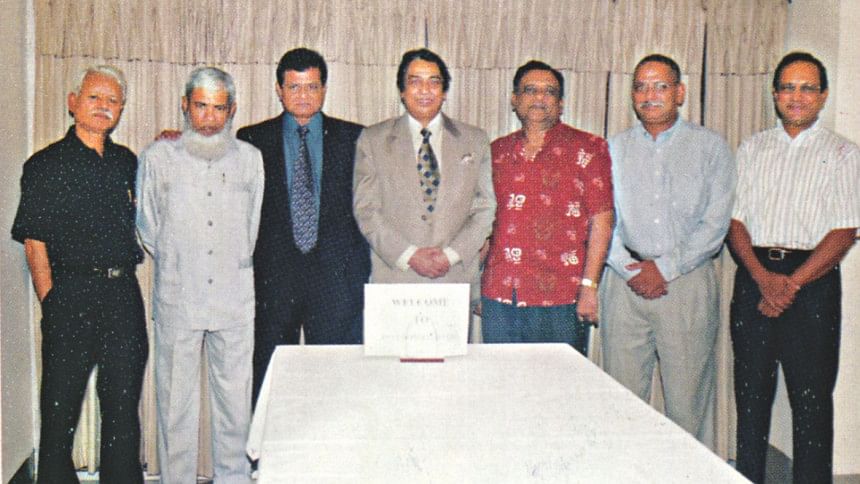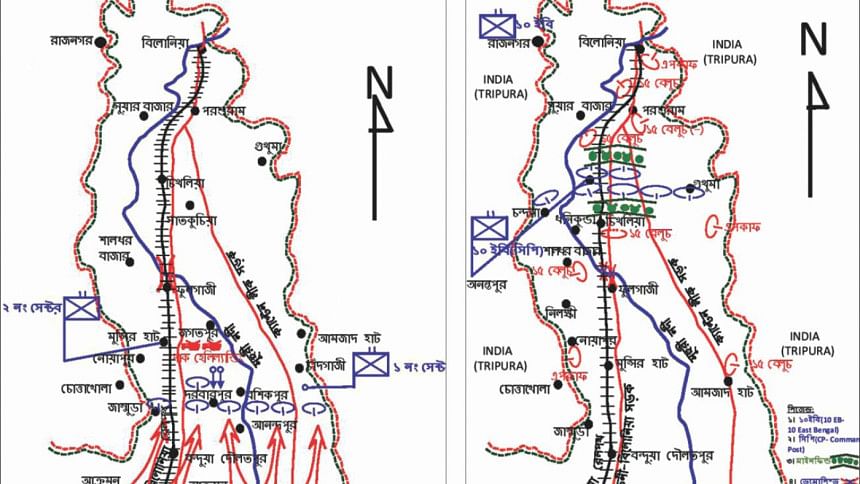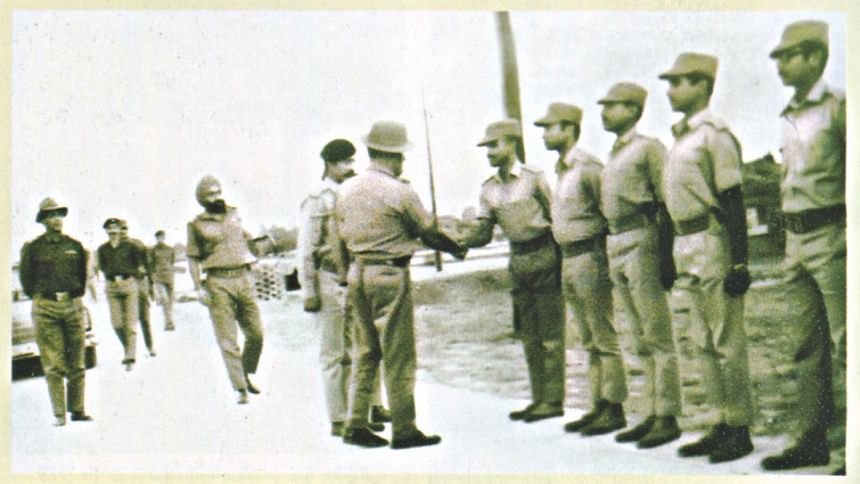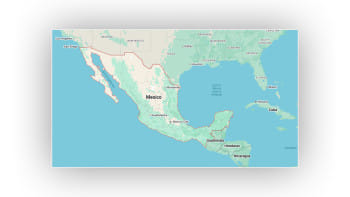BATTLES OF BELONIA BULGE

Feni-Belonia is an enclave of Bangladesh that penetrates the Indian territory, a narrow finger-like strip about 16km-long and 4-6km wide in area. A metre gauge railway track connects Belonia Border Outpost with Feni and two semi-metal roads connect Belonia, one from Chagolnaiyya and another from Feni. The corridor was under the administrative sub-division of Feni, now Feni District, and is surrounded on three sides by Indian territory except the south. Feni town is situated at the south and at the entry point of the enclave. Dhaka-Chittagong highway and Dhaka-Chittagong railway line run through Feni township. Feni river and Muhuri river play a vital role in the topography of the area.
Strategic importance of Feni and Feni-Belonia Bulge
Feni has always been treated as the lifeline between the port city of Chittagong and the capital city of Dhaka. It was the Main Supply Route (MSR) and was considered to be a very important line of communication by the Pakistani occupation forces for movement of their forces, including arms and ammunition, from Chittagong to Dhaka and the rest of the country. Feni, therefore, was treated as a militarily and strategically vital place both by the Pakistani forces and by the freedom fighters. Pakistan also apprehended the installation of Provisional Bangladesh Government at Parshuram in the northern side of the Bulge which was contiguous to the Indian border where Pakistani army would not be able to effectively intervene.
During the nine-month-long Liberation War, Feni-Belonia Bulge had always been a fiercely hot battlefield. To take control of the Bulge, three major battles were fought where freedom fighters successfully applied their improvised tactics. The battles of Belonia Bulge are looked upon as an important chapter of the Liberation War of Bangladesh. The Second Battle of Belonia Bulge has been included in the syllabus/curriculum of Bangladesh Military Academy and many other military academies of the world.
First Battle of Belonia Bulge
With the dual aim of liberation of Feni and establishment of the headquarters of Provisional Bangladesh Government in the liberated territory of the bulge, four companies of freedom fighters under the command of Capt. Jafar Imam, popularly known as Capt. Humayun of Sector #2, covertly infiltrated the enclave from the western side in the Belonia bulge on June 1, 1971. Capt. Jafar Imam established his command post at the bank of the pond of Muktar Bari and deployed his forces at the village of Darbarpur (now under Fulgazi P.S.) covering the strategic place of Feni-Belonia road and rail line. UOTC Capt. Mujibur Rahman Khan acted as the Liaison Officer to the C.O. Capt. Shahidul Islam and his force took position in the village of Jammura and Lt. Imam-uz-Zaman established his defence line in the village of Boshikpur. Capt. Gaffar Haldar was in charge of the rear platoon stationed at Munshirhat. The freedom fighters dug trenches and bunkers and built a strong defence line from the border village of Jammura through Darbarpur and Boshikpur up to the bank of Muhuri river. Simultaneously, the forces of Sector #1 under the command of Maj. Ziaur Rahman along with three companies of freedom fighters entered the eastern side of the bulge near Chandgazi and built their defence line from the border point up to the bank of Muhuri river and established contact with the forces of Sector #2. Maj. Zia established his headquarters near Chandgazi. Capt. Matiur Rahman and his troops took defence adjacent to the border, Lt. Mahfuzur Rahman deployed his troops in the middle and Capt. Oli Ahmed built his defence by the eastern side of Muhuri river. Thus the bulge was sealed off from Feni and rest of the country.
Pakistan army was informed of the penetration of freedom fighters and on June 4, 1971, they callously attacked the positions of freedom fighters, thinking that it was an unconventional and scattered unit. The attack was effectively foiled by the freedom fighters and caused heavy casualties to the enemy. The enemy again attacked the defensive position of the freedom fighters, this time with a battalion on June 7, 9, and 11, under the cover of heavy artillery and mortar fire. The battles continued uninterrupted from June 4 up to June 28. But all of these attacks were successfully repulsed with a lot of courage and bravery with only a few casualties. The enemy lost more than 140 soldiers. The failure of Pakistani forces in driving out the freedom fighters from Belonia Bulge became a prestige issue for them. Hence, to eliminate the freedom fighters, President of Pakistan General Yahya Khan ordered General Abdul Hamid, the Chief of Staff of Pakistan army, to sort it out. General Hamid arrived in Feni via Colombo and Dhaka along with senior Pakistani generals and commanders. He established his headquarters at Feni Circuit House, prepared a detailed assault plan and mobilised a formidable force to face and exterminate the freedom fighters.
As per plan, after sunset on June 21, the Pakistan army dropped a strong contingent of three commando battalions of Pakistan army at the rear of the defence line of the freedom fighters. The commandos attacked the defence line from behind. Simultaneously, the enemy conducted a frontal attack on the entire defensive position of the freedom fighters with a brigade-strength force including tanks under the cover of intensive artillery and mortar shelling. Gunboats of Pakistan navy also attacked the freedom fighters through Muhuri river. Although it was an uneven battle, the freedom fighters valiantly faced the brigade-strength attack of the enemy with great courage and heroism. But Maj. Ziaur Rahman abandoned his defensive position in the evening after the commando attack, withdrew his troops and took shelter inside Indian territory without any information or co-ordination with Capt. Jafar Imam and his forces. Pakistani forces took the advantage and started advancing towards the north by the eastern side of the bulge without facing any resistance.
In the meantime, the Indian army intercepted the wireless communication of Pakistan army and understood the gravity of an all-out assault on all fronts—ground, air and river. Brig. Anand Swarup of the Indian army contacted Capt. Jafar Imam and advised him to withdraw his troops to safety. In such an awkward situation, to save lives at the initial stage of the Liberation War and as a war strategy, Capt. Jafar Imam and his officers withdrew their forces after midnight and retreated inside the Indian territory. Pakistani forces continued their advance, crossed Munshirhat, Fulgazi, Chitholia, Parshuram and reached Belonia. They occupied the entire Feni-Belonia bulge and fortified their position.
The heroic performance of freedom fighters in this battle made it evident that they could attack and face the powerful Pakistani army at a time and place of their choice and overwhelm them. They were not only a volunteer force but were also imbued with patriotism and dedication to confront the enemy face-to-face and give them a taste of defeat. The freedom fighters would be able to liberate Bangladesh if they were provided with enough supply of arms and ammunition, support and logistics. This battle, therefore, was a great moral victory for the freedom fighters in the early phase of our Liberation War.

Second Battle of Belonia Bulge
Capt. Jafar Imam reorganised his forces, engaged with the enemy forces, fought and liberated a small chunk of occupied land at the northwestern side of the bulge and reached the bank of Muhuri river near Shubar Bazar.
Muhuri river from India enters Bangladesh territory by the side of Belonia BOP and moves towards west and then turns to the south. Taking advantage of the location of the river, Capt. Jafar Imam deployed his forces and built a defensive line facing the enemy forces.
Thus, Muhuri river became the dividing line between the Pakistani forces and the freedom fighters. Sporadic clashes continued day and night between the enemy forces and freedom fighters without any decisive results. In the meantime, Capt. Jafar Imam was also assigned as the Rajnagar sub-sector commander covering greater Noakhali including Feni and Chauddogram of Comilla district. Guerilla warfare against Pakistani positions intensified with constant direction and support from the sub-sector commander.
Because of the timely and orderly withdrawal from the first battle, the forces under the command of Capt. Jafar Imam remained intact while acquiring valuable combat experience. On the instruction of Lt. Col. Khaled Mosharrof, the Commander of Sector #2, Capt. Jafar Imam regrouped his forces and on October 10, 1971, raised 10 East Bengal Regiment. The nucleus of 10 East Bengal Regiment was, in fact, developed during the first Battle of the Bulge. Battalion headquarters were established at Rajnagar inside Indian territory, adjacent to the international border in the western side of Belonia town. Capt. Jafar Imam was promoted to the rank of Maj. and became the founding commanding officer (CO) of the battalion. The officers of 10 East Bengal Regiment during and immediately after its formation were:
1) Founding CO Maj. Jafar Imam
2) Alpha Company - Lt. Imam-uz-Zaman
3) Bravo Company - 2/Lt. Syed Mizanur Rahman
4) Charlie Company - 2/Lt. Didar Atwar Hossain
5) Adjutant of the Battalion - Lt. Mokhlesur Rahman
6) Staff Officer (IO) to the CO - FF Ghulam Mustafa
7) Quarter Master - FF Mujibuddin Chowdhury Dulal and
8) Battalion SM - Subedar Maj. Maizur Rahman.
Headquarter Company, including Pioneer Platoon, was under the direct command of the C.O. Maj. Jafar Imam. Pioneer Platoon of the Battalion did a splendid job by laying anti-tank and anti-personnel mines in front of the defence line during both First and Second Battles
of Belonia Bulge which caused heavy casualties to the enemy forces during their advance.
Mines don't recognise friend or foe. So, the accomplishments are duly credited to the Pioneer Platoon freedom fighters for mine-laying, mine-lifting, demolition of bridges/culverts, mining on the roads used by the enemy forces, etc., as they did these risky tasks without any proper professional gadgets like mine detectors, prodders, etc.
In the second week of October, Sector Commander Lt. Col. Khaled Mosharrof, along with Maj. Gen. R.D. Hira, GOC of 23 Mountain Division of Indian army, visited battalion headquarters and defensive positions of 10 East Bengal Regiment. They also examined and evaluated enemy positions and their strength. Based on their personal survey and the intelligence reports, the Indian army constructed a sand model of the Feni-Belonia bulge by depicting the location of rail, road and river including enemy positions inside the bulge. After the detailed sand model discussion, Maj. Jafar Imam was instructed to infiltrate with his battalion inside enemy territory to encircle and attack them decisively. In order to strengthen the forces under Maj. Jafar Imam, Charlie Company of 2 East Bengal Regiment commanded by Capt. Golam Helal Morshed Khan was brought from Sector #3 of Lt. Col. K. M. Shafiullah and was placed under the command of Maj. Jafar Imam. A task force was created comprising of 10 East Bengal Regiment, Charlie Company of 2 East Bengal Regiment and the forces of Sector #1. Maj. Jafar Imam was selected as the task force commander. While 23 Mountain Division of the Indian Army confirmed necessary artillery support, 2 Rajpoot, 3 Dogra and 8 Bihar Regiment of Indian Army were kept ready so that on call of the task force commander, they may act as per needs. But before the execution of this plan, Sector Commander Lt. Col. Khaled was severely wounded on his forehead on October 22, 1971 from enemy artillery shelling at Kamala Shagor near Koshba during an attack on the Pakistani position at Koshba Puran Bazar by 9 East Bengal Regiment under Capt. Mohammad Ainuddin.
In the early morning of October 27, Maj. Jafar Imam entered enemy territory along with the section, platoon and company commanders and conducted an extensive reconnaissance (recce) of the enemy positions. Members of the recce team were dressed like ordinary farmers and labourers, mingled with the local farmers, carried out the recce successfully without arousing any suspicion of the enemy and returned to the defence line safely.
November 5 was fixed as the D-day. It was a cold winter evening. And against the usual weather pattern, after sunset, it started raining heavily and the weather turned ghastly. Thus, nature presented a perfect opportunity for the successful infiltration. At 10:30pm, Bravo Company under the command of 2/Lt. Mizan silently crossed Muhuri river and slowly started the infiltration followed by Charlie Company under 2/Lt. Didar. After a few minutes' pause, Charlie Company of 2nd East Bengal Regiment infiltrated commanded by Capt. Helal Morshed. Alpha Company of 10 East Bengal Regiment commanded by Lt. Imam-uz-Zaman infiltrated thereafter followed by headquarter company under the direct command of Maj. Jafar Imam. Freedom fighters took defensive position covertly from west to east covering Chondona, Sholia and Guthuma and immediately started digging trenches and making bunkers facing both north and south. Maj. Jafar Imam established his command post at Anantapur. Likewise Capt. Mahfuz of Sector #1 crossed the Indian border from eastern side, built defence line up to Guthuma and established contact with Bravo Company of 10 East Bengal Regiment. Thus, the border from east to west was sealed off by the freedom fighters by encircling the enemy forces located at Parshuram and Belonia. Hectic preparation continued throughout the night for the imminent battle.
On November 6, early in the morning, a captain and five soldiers of Pakistan army were seen coming from Feni towards Parshuram/Belonia in a motor-driven railway trolley and reached in front of the defence line of freedom fighters. They were completely unaware of the presence of the guerilla force in their occupied territory. When the enemy trolley crossed the Chitholia railway station and reached within the firing range, Habilder Yar Ahmed of Bravo Company and his men opened heavy fire on them. As a result, all the enemy soldiers, including the captain, died and the trolley with all the arms and ammunition fell scattered. Habilder Yar Ahmed was overcome with joy and emotion. He got out of his bunker with 'Joy Bangla' slogan, rushed to the spot, picked up the rank badges and the revolver of the enemy captain and started running towards his bunker. But unfortunately when he had almost reached the bunker, Pakistani forces from surrounding areas were alerted and started firing sporadically. Habilder Yar Ahmed received a bullet in his left eye and was instantly martyred. It was the first casualty of the freedom fighters, whereas six enemy soldiers fell in the operation! Habilder Yar Ahmed was posthumously awarded the gallantry of 'Bir Bikram'.
After a while, a few enemy patrol and recce parties approached the defensive position of the freedom fighters to assess the situation but ran away due to fire from the defence line of the freedom fighters. After about an hour, our defences were attacked by the enemy forces simultaneously from both north and south. They were beaten back. During November 6-7, the enemy tried to break and penetrate our defence line from the south to rescue their forces under siege at the north, but all of their attempts resulted in utter failure with huge casualties. At about 2:30pm on November 7, four U.S.-made Pakistani Sabre Jets approached our defences and started strafing and bombing our positions. Their heavy machine gun and devastating rocket fire resulted in substantial casualties at our end. However, one of the enemy jets was struck with our heavy machine gun fire and was badly damaged giving out dark plumes of smoke while desperately trying to fly away.
November 8 witnessed a desperate and determined attack by the enemy from the north with the aim of penetrating our defences and break out of the siege but all of their attempts were faced by the freedom fighters with tremendous bravery under the courageous and determined leadership of Capt. Helal Morshed, Lt. Imam, 2/Lt. Mizan and 2/Lt. Didar.
At about 10:30am on November 8, Brigadier B.S. Shandhu, the Brigade Commander of 83
Mountain Brigade of Indian army, along with his Brigade Officers arrived at the Command Post of Maj. Jafar Imam at Anantapur, had elaborate discussions on the battlefield situation and visited the defensive position despite great risk. He assured of necessary artillery support on call of the task force commander. As per the plan, Task Force Commander Maj. Jafar Imam called for artillery support on enemy positions both at Parshuram and Belonia after midnight between November 9 and 10. In the first phase, the divisional artillery of 23 Mountain Division started rapid shelling on enemy positions for about 30 minutes, followed by intense shelling which caused devastating consequences for the enemy.
In the early morning on November 10, the freedom fighters and 3 Dogra Regiment of Indian Army carried out a concerted attack and started advance towards the enemy positions. The morale of the enemy forces broke down completely with huge casualties and fresh thrust of attack. They immediately raised a white flag and after brief formalities a Pakistani captain along with 72 soldiers gave up arms and surrendered to the Mukti and Mitro Bahini (joint forces). Maj. Jafar Imam hoisted the Bangladesh Flag at Parshuram and Belonia while the freedom fighters and a few local residents beaming with pride sang our national anthem 'Amar Sonar Bangla, Ami tomae bhalobashi'. The entire area of Parshuram and Belonia was thus liberated on November 10, 1971. This was the first major setback for the enemy and surrender of such a large number of Pakistani forces to the freedom fighters and a major strategic victory of the Bangladesh Liberation Forces. In fact, this was the beginning of the end for the Pakistani occupation forces.
The techniques applied by freedom fighters in this historic battle were a gross violation to tactical teachings and conventional military ethics. There was no depth between the two defence lines which, in fact, were back-to-back! It was also not only a battle of brawn but also a battle of brain and wisdom. There is an expression: “Nothing succeeds like success.” In the year
1973, a good number of senior army generals from around the world visited the battlefield of Belonia with a lot of curiosity. The new technique, so successfully applied by the freedom fighters during the second Battle of Belonia Bulge, has been recognised and accepted as a war technique. In between the First and Second Battles of Belonia Bulge, 10 East Bengal Regiment under the command of Maj. Jafar Imam and his officers demolished bridges, laid anti-tank and anti-personnel mines on the roads frequently used by the Pakistani forces, conducted many ambushes and raids on enemy positions by inflicting heavy casualties to them. The First, Second and Third Battles of Belonia Bulge including innumerable ambushes and raids resulted in about 1,000 casualties to the enemy forces.

Third Battle of Belonia Bulge
After the surrender of Pakistani forces at Belonia, 'K' Force was reorganised and renamed as 'Kilo' Force under the command of Brig. Anand Swarup of Indian army comprising of 4 East Bengal Regiment and 10 East Bengal Regiment including 31 Jat Regiment and 32 Mahar Regiment from Mizo Hill Range. Kilo Force started advance to liberate Feni but faced stiff resistance from the enemy forces near Feni at a place called Pathan Nagar and its surrounding areas. Sporadic and heavy battle continued between the Kilo Force and the Pakistani forces from November 20 up to December 5. Kilo Force attacked the Pakistani positions with new vigour. Facing heavy casualties, the defeated remnant Pakistani forces abandoned Feni and disgracefully fled towards Comilla and Chittagong cantonments. With unprecedented joy of the local population and with the thunderous 'Joy Bangla' slogan, Feni and Noakhali were liberated on December 6 and 9 respectively. Kilo Force continued their advance towards Chittagong. After reaching Kumira, Maj. Jafar Imam left Charlie Company there under the command of 2/Lt. Didar and started a difficult advance towards Hathajari through the hills and jungles by the left side of Dhaka-Chittagong highway. At Hathajari, his forces along with the forces of 4 East Bengal Regiment under the command of Capt. Gaffar Halder attacked the 24 Frontier Force Regiment and defeated it. At Kumira Bazar, 2/Lt. Didar and his troops had a fierce battle with the Pakistani forces. At one stage of the battle, the demoralised enemy forces fled towards Chittagong Cantonment. And the hostilities ended on December 16, 1971 with the surrender of Pakistani forces to the joint command of freedom fighters and the Indian Army at Natun Para Cantonment at Chittagong.
The regular and citizen soldiers together ended the war. The battalion was thus rightly conferred with the nom de plume 'Durdhorsho Dosh' (The Daring Ten) of the 10th Battalion of the East Bengal Regiments.
The patriotism, heroism and immense bravery of all ranks of 10 East Bengal Regiment in defeating the Pakistani forces and in liberating the Feni-Belonia Bulge shall always imbue the nation and successive generations with pride and patriotism.
The writer was Intelligence Officer (I.O.) to the Commanding Officer (C.O.) of 10 East Bengal Regiment during the Liberation War of Bangladesh in the year 1971. He can be reached at: [email protected]

 For all latest news, follow The Daily Star's Google News channel.
For all latest news, follow The Daily Star's Google News channel. 



Comments